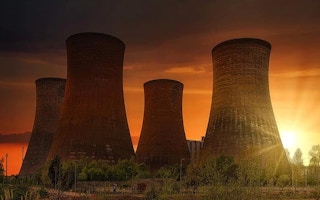Pakistan risks locking itself into polluting and expensive electricity generation capacity if it follows energy strategies laid out in its latest power expansion plan, a new report by the Institute for Energy Economics and Financial Analysis (IEEFA) has found.
To continue reading, subscribe to Eco‑Business.
There's something for everyone. We offer a range of subscription plans.
- Access our stories and receive our Insights Weekly newsletter with the free EB Member plan.
- Unlock unlimited access to our content and archive with EB Circle.
- Publish your content with EB Premium.
The power plan, published by state-owned utility firm National Transmission and Despatch Company in April, charts a development pathway for the country’s electricity generation sector over the next 27 years and is expected to result in more affordable and sustainable electricity for its citizens.
But instead, the roadmap could see Pakistan leave its cheap and abundant renewable energy resources largely untouched after this decade, and build more coal and liquefied natural gas power plants than it needs, saddling the country with a significant financial burden, warns the analysis.
Under the plan’s base-case scenario, the South Asian nation’s imported coal power plants are estimated to run at only 14 per cent of their capacity by 2030, with utilisation rates for imported gas-fired stations set to stand at 22 per cent.
The plan’s long-term vision does not look any rosier. Between 2030 and 2047, the nation targets the addition of 20,000 megawatts (MW) of gas-fired power capacity, with utilisation at virtually zero by 2047, and another 5,300 MW of imported coal power generation capacity, with usage at 15 per cent.
But Pakistan’s looming overcapacity problem could be much bigger than assumed, as the roadmap’s scenarios are based on overestimated energy demand growth forecasts that do not take the coronavirus-induced economic slump into account, states the analysis.
There is a significant risk that actual utilisation rates for thermal power will be even lower than predicted, bringing about a host of issues. Power plants that burn imported fuels could lie dormant much of the time, posing a significant stranded asset risk.
Generators become stranded assets when they no longer yield sufficient returns, locking countries in increasingly expensive electricity for decades as power stations would require generous subsidies to operate commercially.
“The Pakistan government’s principle of affordability cannot be met if the power system is locked into long-term overcapacity. Capacity payments to plants lying idle are already an issue and would become even more unsustainable if more overcapacity is locked in,” said Simon Nicholas, IEEFA energy finance analyst, and the author of the report.
Pakistan’s extensive fossil fuel plans would also see the country’s climate impacts grow substantially, causing carbon emission to almost triple by 2047 relative to 2020 levels, even under the roadmap’s base scenario, which assumes lower future power demand growth.
Intermittency fears
Part of the reason why Pakistan plans to put up with challenges linked to overcapacity is concerns that such reserves are needed as backup to accommodate more variable renewables, such as solar and wind, whose power output fluctuates depending on weather patterns.
The report describes this assumption as “wildly inaccurate”, pointing to ever-cheaper energy storage as a more sensible solution. It states that any concerns about the ability of Pakistan’s power grid to cope with the growing influx of intermittent clean electricity could be resolved by thoroughly planning grid upgrades now.
New connections, for instance, could transport electricity over vast distances to areas where wind and sunshine are temporarily unavailable. Increasingly, green hydrogen produced from clean energy is also expected to play a role globally as a fuel that could power industries and households alike.
But, ironically, Pakistan’s latest power plan rebuffs modern clean energy after this decade. While it aims to meet the government’s goal of boosting the share of renewables in the mix to 30 per cent by 2030, up from 4 per cent today, it forecasts that the overall contribution of green power will decline from 31 per cent in 2030 to 23 per cent in 2047, with no further wind additions at all.
This is even though wind and solar are already the cheapest sources of new power generation in Pakistan. Nicholas said that modelling declining contribution from renewables after this decade made the strategy look “very much out of touch with current power trends”.
So far in 2020, two more Chinese-financed coal-fired plants in Pakistan have reached financial closure. This means the projects have fulfilled all conditions of their financing agreements and can commence construction. But there are more ventures in the pipeline.
By 2047, the plan’s base-case scenario predicts that the country will have a total coal power capacity of more than 38 gigawatts (GW), up from about 3 GW in 2018, and 30 GW of liquefied natural gas capacity, more than double the capacity installed two years ago.
In 2018, the UN’s Intergovernmental Panel on Climate Change examined how rapidly global coal power would need to be phased out to give the world a chance of capping global warming at 1.5 degrees Celsius.
It found this would require a reduction of 59 per cent to 78 per cent below 2010 levels by 2030, before declining to zero.










